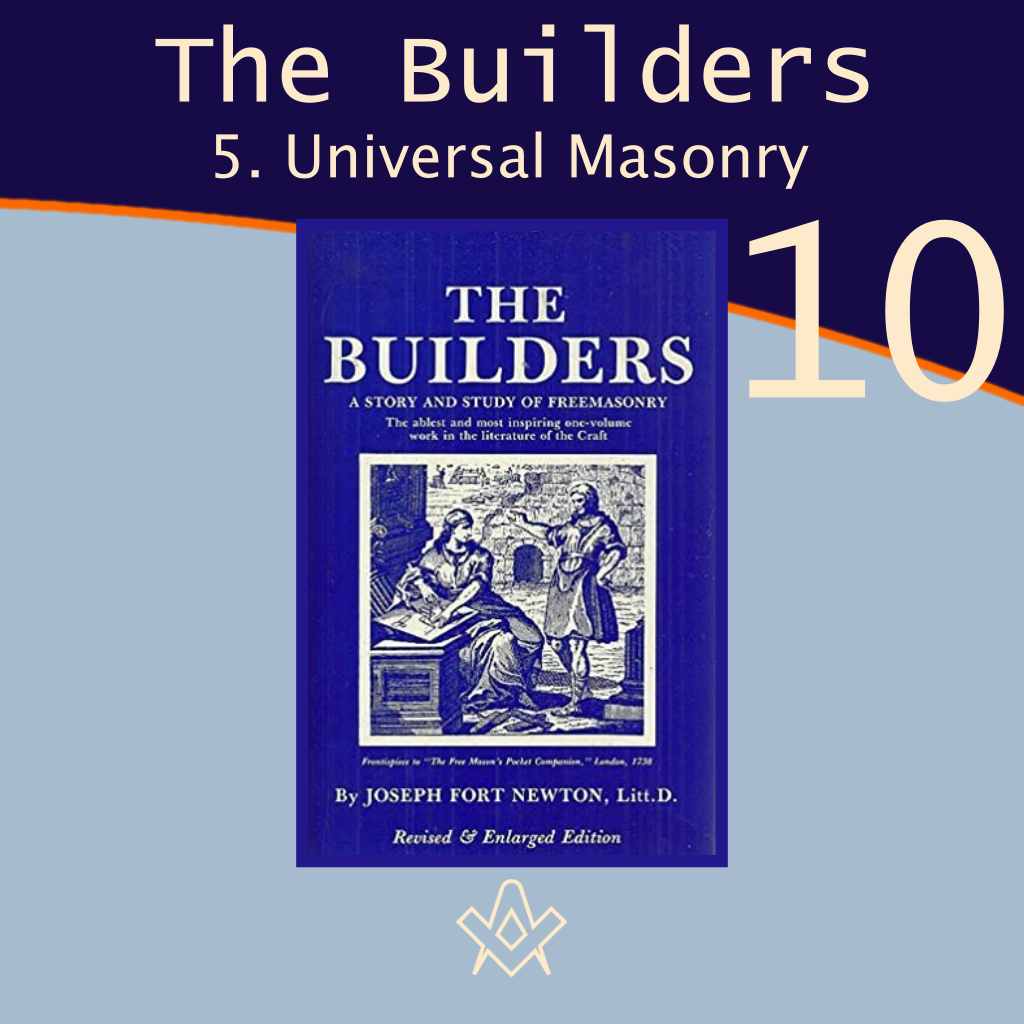In 1915, Joseph Fort Newton’s book, ‘The Builders: A Story and Study of Freemasonry’ was published.
It has become a Masonic classic in as much that it really does lay the foundations of knowledge for us to build upon.
These signs and tokens are of no small value; they speak a universal language, and act as a passport to the attention and support of the initiated in all parts of the world. They cannot be lost so long as memory retains its power.
Let the possessor of them be expatriated, ship-wrecked, or imprisoned; let him be stripped of everything he has got in the world; still these credentials remain and are available for use as circumstances require.
The great effects which they have produced are established by the most incontestable facts of history.
They have stayed the uplifted hand of the destroyer; they have softened the asperities of the tyrant; they have mitigated the horrors of captivity; they have subdued the rancor of malevolence, and broken down the barriers of political animosity and sectarian alienation.
On the field of battle, in the solitude of the uncultivated forests, or in the busy haunts of the crowded city, they have made men of the most hostile feelings, and most distant religions, and the most diversified conditions, rush to the aid of each other, and feel a social joy and satisfaction that they have been able to afford relief to a brother Mason.
– BENJAMIN FRANKLIN
Chapter 10 – Universal Masonry
I
HENCEFORTH the Masons of England were no longer a society of handicraftsmen, but an association of men of all orders and every vocation, as also of almost every creed, who met together on the broad basis of humanity, and recognized no standard of human worth other than morality, kindliness, and love of truth.
They retained the symbolism of the old Operative Masonry, its language, its legends, its ritual, and its oral tradition.
No longer did they build churches, but the spiritual temple of humanity; using the Square not to measure right angles of blocks of stone, but for evening the inequalities of human character, nor the Compass any more to describe circles on a tracing-board, but to draw a Circle of goodwill around all mankind.
Howbeit, one generation of men, as Hume re-marks, does not go off the stage at once, and another succeed, like silkworms and butterflies.
No more did this metamorphosis of Masonry, so to name it, take place suddenly or radically, as it has become the fashion to think. It was a slow process, and like every such period the Epoch of Transition was attended by many problems, uncertainties, and difficulties.
Some of the Lodges, as we have noted, would never agree to admit Accepted Masons, so jealous were they of the ancient landmarks of the Craft.
Even the Grand Lodge, albeit a revival of the old Assembly, was looked upon with suspicion by not a few, as tending toward undue centralization; and not without cause.
From the first the Grand Master was given more power than was ever granted to the President of an ancient Assembly; of necessity so, perhaps, but it led to misunderstanding. Other influences added to the confusion, and at the same time emphasized the need of welding the order into a more coherent unity for its wider service to humanity.

Portrait of the English antiquarian William Stukeley attributed to Richard Collins. Society of Antiquaries of London, Burlington House
IMAGE LINKED: wikimedia Attribution 4.0 International (CC BY 4.0)
There are hints to the effect that the new Masonry, if so it may be called, made very slow progress in the public favor at first, owing to the conditions just stated; and this despite the remark of Anderson in June, 1719:
“Now several old Brothers that had neglected the Craft, visited the Lodges; some Noblemen were also made Brothers, and more new Lodges were constituted.”
Stuckely, the antiquarian, tells us in his Diary under date of January, 1721—at which time he was initiated—that he was the first person made a Mason in London for years, and that it was not easy to find men enough to perform the ceremony. Incidentally, he confides to us that he entered the order in search of the long hidden secrets of “the Ancient Mysteries.”
No doubt he exaggerated in the matter of numbers, though it is possible that initiations were comparatively few at the time, the Lodges being recruited, for the most part, by the adhesion of old Masons, both Operative and Speculative; and among his friends he may have had some difficulty in finding men with an adequate knowledge of the ritual.
But that there was any real difficulty in gathering together seven Masons in London is, on the face of it, absurd.
Immediately thereafter, Stuckely records, Masonry “took a run, and ran itself out of breath through the folly of its members,” but he does not tell us what the folly was.
The “run” referred to was almost certainly due to the acceptance by the Duke of Montagu of the Grand Mastership, which gave the order a prestige it had never had before; and it was also in the same year, 1721, that the old Constitutions of the Craft were revised.
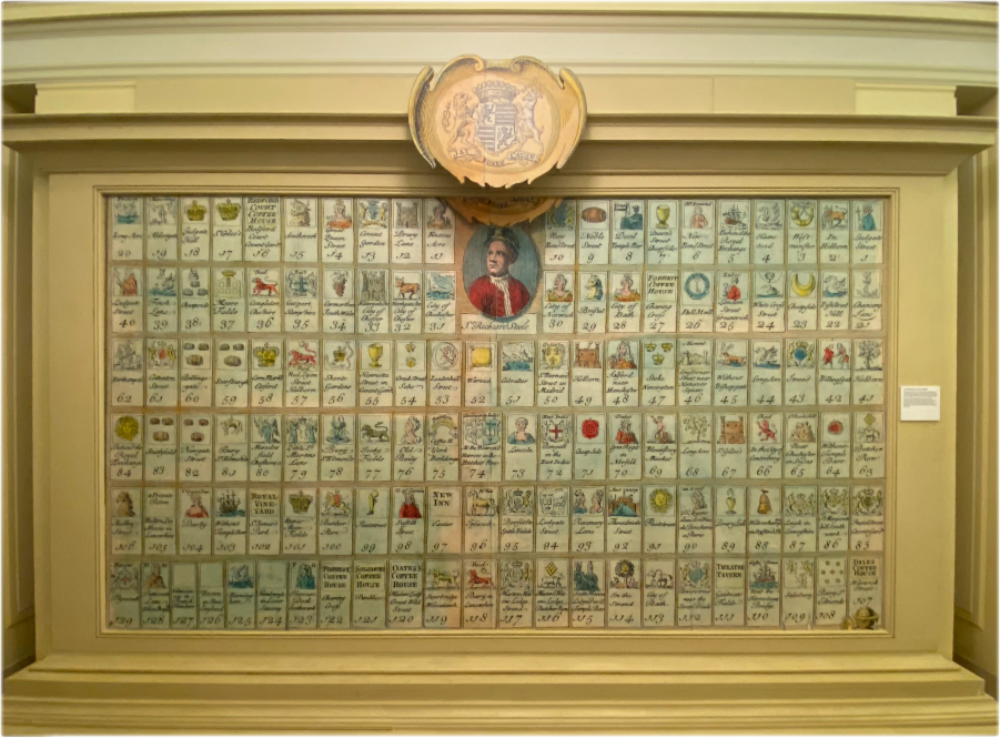
Lane’s Record of Lodges at Freemasons’ Hall England
Photo: Publisher’s collection
Twelve Lodges attended the June quarterly communication of the Grand Lodge in 1721, sixteen in September, twenty in December, and by April, 1723, the number had grown to thirty.
All these Lodges, be it noted, were in London, a fact amply justifying the optimism of Anderson in the last paragraph of the Book of Constitutions, issued in that year.
So far the Grand Lodge had not extended its jurisdiction beyond London and Westminster, but the very next year, 1724, there were already nine Lodges in the provinces acknowledging its obedience, the first being the Lodge at the Queen’s Head, City of Bath.
Within a few years Masonry extended its labors abroad, both on British and on foreign soil.
The first Lodge on foreign soil was founded by the Duke of Wharton at Madrid, in 1728, and regularized the following year, by which time a Lodge had been established at the East India Arms, Bengal, and also at Gibraltar.
It was not long before Lodges arose in many lands, founded by English Masons or by men who had received initiation in England; these Lodges, when sufficiently numerous, uniting under Grand Lodges—the old Lodge at York, that ancient Mecca of Masonry, had called itself a Grand Lodge as early as 1725.
The Grand Lodge of Ireland was created in 1729, those of Scotland and France in 1736; a Lodge at Hamburg in 1737, though it was not patented until 1740; the Unity Lodge at Frankfort-on-the-Main in 1742, another at Vienna the same year; the Grand Lodge of the Three World-spheres at Berlin in 1744; and so on, until the order made its advent in Sweden, Switzer-land, Russia, Italy, Spain, and Portugal.
Following the footsteps of Masonry from land to land is almost as difficult as tracing its early history, owing to the secrecy in which it enwrapped its movements.
For example, in 1680 there came to South Carolina one John Moore, a native of England, who before the close of the century removed to Philadelphia, where, in 1703, he was Collector of the Port.
In a letter written by him in 1715, he mentions having; “spent a few evenings in festivity with my Masonic brethren.”
This is the first vestige of Masonry in America, unless we accept as authentic a curious document in the early history of Rhode Island, as follows:
“This ye [day and month obliterated] 1656, Wee mett att y House off Mordicai Campanell and after synagog gave Abram Moses the degrees of Maconrie.”
On June 5, 1730, the first authority for the assembling of Free-masons in America was issued by the Duke of Norfolk, to Daniel Coxe, of New Jersey, appointing him Provincial Grand Master of New York, New Jersey, and Pennsylvania; and three years later Henry Price, of Boston, was appointed to the same office for New England.
But Masons had evidently been coming to the New World for years, for the two cases just cited date back of the Grand Lodge of 1717.
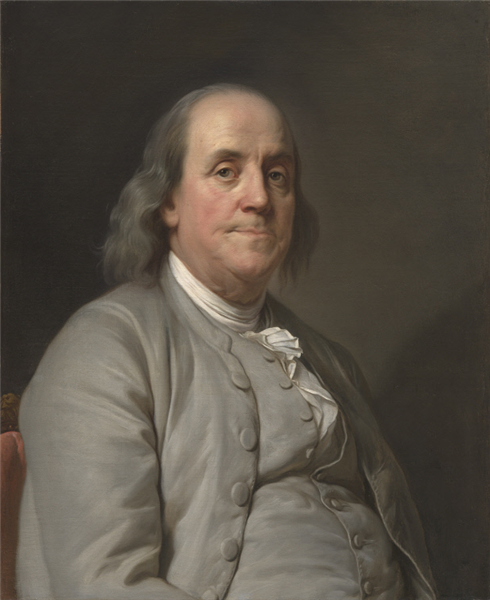
Portrait of Benjamin Franklin
IMAGE LINKED: wikimedia Attribution 4.0 International (CC BY 4.0)
How soon Coxe acted on the authority given him is not certain, but the Pennsylvania Gazette, published by Benjamin Franklin, contains many references to Masonic affairs as early as July, 1730.
Just when Franklin himself became interested in Masonry is not of record—he was initiated in 1730-31 —but he was a leader, at that day, of everything that would advance his adopted city; and the “Junto,” formed in 1725, often inaccurately called the Leathern-Apron Club, owed its origin to him.
In a Masonic item in the Gazette of December 3, 1730, he refers to “several Lodges of Free-masons” in the Province, and on June 9, 1732, notes the organization of the Grand Lodge of Pennsylvania, of which he was appointed a Warden, at the Sun Tavern, in Water Street.
Two years later Franklin was elected Grand Master, and the same year published an edition of the Book of Constitutions—the first Masonic book issued in America.
Thus Masonry made an early advent into the new world, in which it has labored so nobly, helping to lay the foundations and building its own basic principles into the organic law of the greatest of all republics.
II
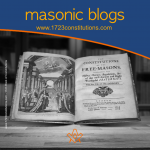
Masonic Blogs – 1723constitutions
1723constitutions.com/ masonic blog marks the tercentenary of the publication in London of The Constitutions of the Freemasons – the ‘1723 Constitutions’
more….
Returning to the Grand Lodge of England, we have now to make record of ridicule and opposition from without, and, alas, of disloyalty and discord within the order itself.
With the publication of the Book of Constitutions, by Anderson, in 1723, the platform and principles of Masonry became matters of common knowledge, and its enemies were alert and vigilant.
None are so blind as those who will not see, and not a few, unacquainted with the spirit of Masonry, or unable to grasp its principle of liberality and tolerance, affected to detect in its secrecy some dark political design; and this despite the noble charge in the Book of Constitutions enjoining politics from entering the lodge—a charge hardly less memorable than the article defining its attitude toward differing religious creeds, and which it behooves Masons to keep always in mind as both true and wise, especially in our day when effort is being made to inject the religious issue into politics:
In order to preserve peace and harmony no private piques or quarrels must be brought within the door of p. 209 the Lodge, far less any quarrel about Religions or Nations or State-Policy, we being only, as Masons, of the Catholic Religion above mentioned (the religion in which all men agree); we are also of all Nations, Tongues, Kindreds and Languages, and are resolved against all Politics as what never yet conduced to the welfare of the Lodge, nor ever will. This charge has always been actively enjoined and observed; but especially ever since the Reformation in Britain or the dissent and secession of these Nations from the communion of Rome.

The Gormogons
The Antient Noble Order of the Gormogons had a brief existence in the eighteenth century; they left few records or accomplishments,
more….
No sooner had these noble words been printed, than there came to light a secret society calling itself the “truly Ancient Noble Order of the Gormogons,” alleged to have been instituted by Chin-Quaw Ky-Po, the first Emperor of China, many thousand years before Adam.
Notice of a meeting of the order appeared in the Daily Post, September 3, 1723, in which it was stated, among other high-sounding declarations, that “no Mason will be received as a Member till he has renounced his noble order and been properly degraded.”
Obviously, from this notice and others of like kind—all hinting at the secrets of the Lodges—the order was aping Masonry by way of parody with intent to destroy it, if possible, by ridicule. For all that, if we may believe the Saturday Post of October following, “many eminent Freemasons” had by that time “degraded themselves” and gone over to the Gormogons.
Not “many” perhaps, but, alas, one eminent Mason at least, none other than a Past Grand Master, the Duke of Wharton, who, piqued at an act of the Grand Lodge, had turned against it.
Erratic of mind, unstable of morals, having an inordinate lust for praise, and pilloried as a “fool” by Pope in his Moral Essays, he betrayed his fraternity—as, later, he turned traitor to his faith, his flag, and his native land!
Simultaneously with the announcement that many eminent Masons had “degraded themselves”—words most fitly chosen—and gone over to the Gormogons, there appeared a book called the Grand Mystery of Freemasons Discovered, and the cat was out of the bag.
Everything was plain to the Masons, and if it had not been clear, the way in which the writer emphasized his hatred of the Jesuits would have told it all.
It was a Jesuit plot hatched in Rome to expose the secrets of Masonry, and making use of the dissolute and degenerate Mason for that purpose—tactics often enough used in the name of Jesus! Curiously enough, this was further made evident by the fact that the order ceased to exist in 1738, the year in which Clement XII published his Bull against the Masons.
Thereupon the “ancient order of Gormogons” swallowed itself, and so disappeared—not, however, without one last, futile effort to achieve its ends. Naturally this episode stirred the Masons deeply.
It was denounced in burning words on the floor of the Grand Lodge, which took new caution to guard its rites from treachery and vandalism, in which respects it had not exercised due care, admitting men to the order who were unworthy of the honor.
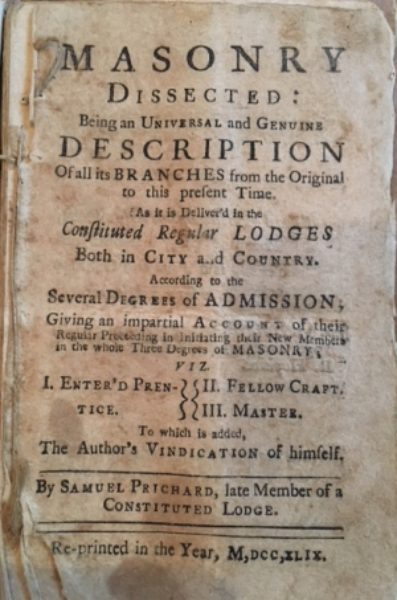
Samuel Prichard’s masonry dissected 1730
IMAGE LINKED: nationalheritagemuseum.typepad.com/library_and_archives/masonry-dissected/
There were those who thought that the power of Masonry lay in its secrecy; some think so still, not knowing that its real power lies in the sanctity of its truth, the simplicity of its faith, the sweetness of its spirit, and its service to mankind, and that if all its rites were made public today it would still hold the hearts of men.
Nevertheless, of alleged exposures there were many between 1724 and 1730, both anonymous and signed, and they made much ado, especially among men who were not Masons.
It will be enough to name the most famous, as well as the most elaborate, of them all, Masonry Dissected, by Samuel Prichard, which ran through three editions in one month, October, 1730, and called out a noble Defence of Masonry, written, it is thought, by Anderson, but the present writer believes by Desaguliers.
Others came later, such as J****n and B**z, the Three Distinct Knocks, and so forth. They had their day and ceased to be, having now only an antiquarian interest to those who would know the manners and customs of a far-off time.
Instead of injuring the order, they really helped it, as such things usually do, by showing that there must be something to expose since so many were trying to do it.
But Masonry went marching on, leaving them behind in the rubbish of things forgotten, as it does all its back-stair spies and heel-snapping critics.
More serious by far was the series of schisms within the order which began in 1725, and ran on even into the next century.
For the student they make the period very complex, calculated to bewilder the beginner; for when we read of four Grand Lodges in England, and for some years all of them running at once, and each one claiming to be the Grand Lodge of England, the confusion seems not a little confounded.
Also, one Grand Lodge of a very limited territory, and few adherents, adopted the title of Grand Lodge of all England, while another which commenced in the middle of the century assumed the title of “The Ancients,” and dubbed the older and parent Grand Lodge “The Moderns.”
Besides, there are traces of an unrecorded Grand body calling itself “The Supreme Grand Lodge,” as if each were trying to make up in name what was lacking in numbers. Strict search and due inquiry into the causes of these divisions would seem to show the following results:
First, there was a fear, not unjustified by facts, that the ancient democracy of the order had been infringed upon by certain acts of the Grand Lodge of 1717—as, for example, giving to the Grand Master power to appoint the Wardens.
Second, there was a tendency, due to the influence of some clergymen active in the order, to give a distinctively Christian tinge to Masonry, first in their interpretations of its symbols, and later to the ritual itself.
This fact has not been enough emphasized by our historians, for it explains much.
Third, there was the further fact that Masonry in Scotland differed from Masonry in England, in details at least, and the two did not all at once harmonize, each being rather tenacious of its usage and tradition, Fourth, in one instance, if no more, pride of locality and historic memories led to independent organization.
Fifth, there was the ever-present element of personal ambition with which all human societies, of whatever kind, must reckon at all times and places this side of heaven.
Altogether, the situation was amply conducive to division, if not to explosion, and the wonder is that the schisms were so few.
III
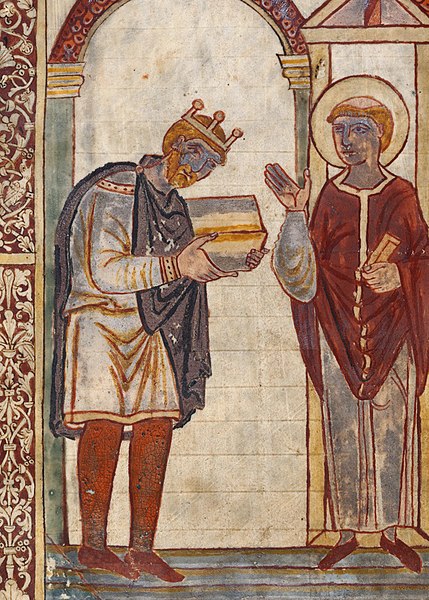
king Athelstan
IMAGE LINKED: wikimedia Attribution 4.0 International (CC BY 4.0)
Time out of mind the ancient city of York had been a seat of the Masonic Craft, tradition tracing it back to the days of Athelstan, in 926 A. D. Be that as it may, the Lodge minutes of York are the oldest in the country, and the relics of the Craft now preserved in that city entitle it to be called the Mecca of Masonry.
Whether the old society was a Private or a Grand Lodge is not plain; but in 1725 it assumed the title of the “Grand Lodge of All England,”—feeling, it would seem, that its inherent right by virtue of antiquity had in some way been usurped by the Grand Lodge of London.
After ten or fifteen years the minutes cease, but the records of other grand bodies speak of it as still working.
In 1761 six of its surviving members revived the Grand Lodge, which continued with varying success until its final extinction in 1791, having only a few subordinate Lodges, chiefly in Yorkshire. Never antagonistic, it chose to remain independent, and its history is a noble tradition.
York Masonry was acknowledged by all parties to be both ancient and orthodox, and even to this day, in England and over the seas, a certain mellow, magic charm clings to the city which was for so long a meeting place of Masons.
Far more formidable was the schism of 1753, which had its origin, as is now thought, in a group of Irish Masons in London who were not recognized by the premier Grand Lodge.
Whereupon they denounced the Grand Lodge, averring that it had adopted “new plans” and departed from the old landmarks, reverted, as they alleged, to the old forms, and set themselves up as Ancient Masons—bestowing upon their rivals the odious name of Moderns.
Later the two were further distinguished from each other by the names of their respective Grand Masters, one called Prince of Wales’ Masons, the other the Atholl Masons.
The great figure in the Atholl Grand body was Lawrence Dermott, to whose keen pen and indefatigable industry as its secretary for more than thirty years was due, in large measure, its success.
In 1756 he published its first book of laws, entitled Ahiman Rezon, Or Help to a Brother, much of which was taken from the Irish Constitutions of 1751, by Pratt, and the rest from the Book of Constitutions, by Anderson—whom he did not fail to criticize with stinging satire, of which he was a master.
Among other things, the office of Deacon seems to have had its origin with this body.
Atholl Masons were presided over by the Masters of affiliated Lodges until 1756, when Lord Blessington, their first titled Grand Master, was induced to accept the honor—their warrants having been left blank betimes, awaiting the coming of a Nobleman to that office.

John Murray, 4th Duke of Atholl (1755-1830). Piece is an engraving of an earlier portrait. Contemporary portrait. Engraving published 1811.
IMAGE LINKED: wikimedia Attribution 4.0 International (CC BY 4.0)
Later the fourth Duke of Atholl was Grand Master at the same time of Scotland and of the Atholl Grand Lodge, the Grand Lodges of Scotland and Ireland being represented at his installation in London.
Still another schism, not serious but significant, came in 1778, led by William Preston, who afterwards became a shining light in the order. On St. John’s Day, December 27, 1777, the Antiquity Lodge of London, of which Preston was Master—one of the four original Lodges forming the Grand Lodge—attended church in a body, to hear a sermon by its Chaplain.
They robed in the vestry, and then marched into the church, but after the service they walked back to the Hall wearing their Masonic clothing.
Difference of opinion arose as to the regularity of the act, Preston holding it to be valid, if for no other reason, by virtue of the inherent right of Antiquity Lodge itself.
Three members objected to his ruling and appealed to the Grand Lodge, he foolishly striking their names off the Lodge roll for so doing.
Eventually the Grand Lodge took the matter up, decided against Preston, and ordered the reinstatement of the three protesting members.
At its next meeting the Antiquity Lodge voted not to comply with the order of the Grand Lodge, and, instead, to withdraw from that body and form an alliance with the “Old Grand Lodge of All England at York City,” as they called it.
They were received by the York Grand Lodge, and soon thereafter obtained a constitution for a “Grand Lodge of England South of the Trent.”
Although much vitality was shown at the outset, this body only constituted two subordinate Lodges, and ceased to exist.
Having failed, in 1789 Preston and his friends recanted their folly, apologized to the Grand Lodge, reunited with the men whom they had expelled, and were received back into the fold; and so the matter ended.
These divisions, while they were in some ways unhappy, really made for the good of the order in the sequel—the activity of contending Grand Lodges, often keen, and at times bitter, promoting the spread of its principles to which all were alike loyal, and to the enrichment of its Ritual to which each contributed.
Dermott, an able executive and audacious antagonist, had left no stone unturned to advance the interests of Atholl Masonry, inducing its Grand Lodge to grant warrants to army Lodges, which bore fruit in making Masons in every part of the world where the English army went.
Howbeit, when that resourceful secretary and uncompromising fighter had gone to his long rest, a better mood began to make itself felt, and a desire to heal the feud and unite all the Grand Lodges—the way having been cleared, meanwhile, by the demise of the old York Grand Lodge and the “Grand Lodge South of the Trent.”
Overtures to that end were made in 1802 without avail, but by 1809 committees were meeting and reporting on the “propriety and practicability of union.”
Fraternal letters were exchanged, and at last a joint committee met, canvassed all differences, and found a way to heal the schism.
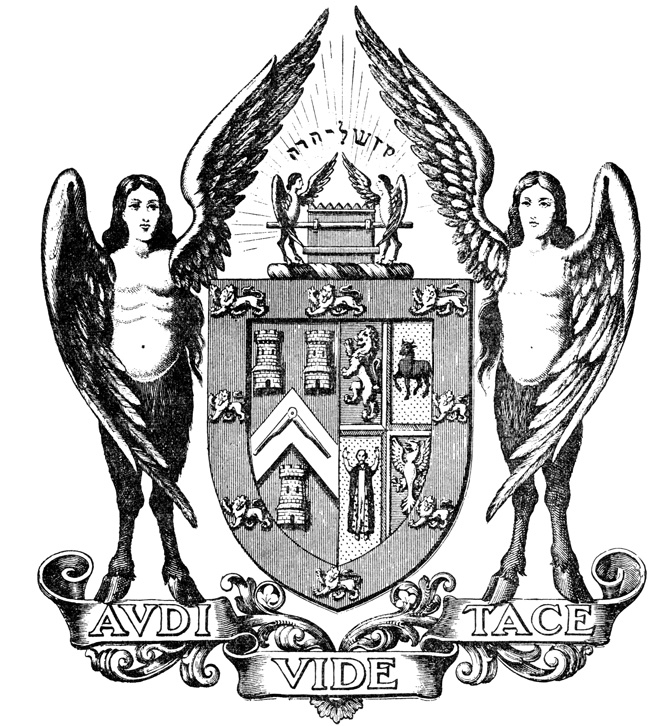
Arms of the United Grand Lodge of England
Union came at length, in a great Lodge of Reconciliation held in Freemasons’ Hall, London, on St. John’s Day, December 27, 1813.
It was a memorable and inspiring scene as the two Grand Lodges, so long estranged, filed into the Hall—delegates of 641 Modern and 359 Ancient or Atholl Lodges—so mixed as to be indistinguishable the one from the other. Both Grand Masters had seats of honor in the East.
The hour was fraternal, each side willing to sacrifice prejudice in behalf of principles held by all in common, and all equally anxious to preserve the ancient landmarks of the Craft—a most significant fact being that the Atholl Masons had insisted that Masonry erase such distinctively Christian color as had crept into it, and return to its first platform.
Once united, free of feud, cleansed of rancor, and holding high its unsectarian, non-partisan flag, Masonry moved forward to her great ministry. If we would learn the lesson of those long dead schisms, we must be vigilant, correcting our judgments, improving our regulations, and cultivating that spirit of Love which is the fountain whence issue all our voluntary efforts for what is right and true: union in essential matters, liberty in everything unimportant and doubtful; Love always—one bond, one universal law, one fellowship in spirit and in truth!
IV
Remains now to give a glimpse—and, alas, only a glimpse—of the growth and influence of Masonry in America; and a great story it is, needing many volumes to tell it aright.
As we have seen, it came early to the shores of the New World, long before the name of our great republic had been uttered, and with its gospel of Liberty, Equality, and Fraternity it helped to shape the institutions of this Continent.
Down the Atlantic Coast, along the Great Lakes, into the wilderness of the Middle West and the forests of the far South—westward it marched as “the star of empire” led, setting up its altar on .remote frontiers, a symbol of civilization, of loyalty to law and order, of friendship with school-house and church.
If history recorded the unseen influences which go to the making of a nation, those forces for good which never stop, never tarry, never tire, and of which our social order is the outward and visible sign, then might the real story of Masonry in America be told.

The Green Dragon Tavern
What the Goose and Gridiron Tavern is in the ancient annals of London Freemasonry, The Green Dragon Tavern is to the memories of the Free-mason, of Boston and New England.
more….
Instead of a dry chronicle, let us make effort to capture and portray the spirit of Masonry in American history, if so that all may see how this great order actually presided over the birth of the republic, with whose growth it has had so much to do.
For example, no one need be told what patriotic memories cluster about the old Green Dragon Tavern, in Boston, which Webster, speaking at Andover in 1823, called “the headquarters of the Revolution.”
Even so, but it was also a Masonic Hall, in the “Long Room” of which the Grand Lodge of Massachusetts—an off-shoot of St. Andrew’s Lodge—was organized on St. John’s Day, 1767, with Joseph Warren, who afterwards fell at Bunker Hill, as Grand Master.
There Samuel Adams, Paul Revere, Warren, Hancock, Otis and others met and passed resolutions, and then laid schemes to make them come true.
There the Boston Tea Party was planned, and executed by Masons disguised as Mohawk Indians—not by the Lodge as such, but by a club formed within the Lodge, calling itself the Caucus Pro Bono Publico, of which Warren was the leading spirit, and in which, says Elliott, “the plans of the Sons of Liberty were matured.”
As Henry Purkett used to say, he was present at the famous Tea Party as a spectator, and in disobedience to the order of the Master of the Lodge, who was actively present.
As in Massachusetts, so throughout the Colonies—the Masons were everywhere active in behalf of a nation “conceived in liberty and dedicated to the proposition that all men are created equal.”
Of the men who signed the Declaration of Independence, the following are known to have been members of the order: William Hooper, Benjamin Franklin, Matthew Thornton, William Whipple, John Hancock, Philip Livingston, Thomas Nelson; and no doubt others, if we had the Masonic records destroyed during the war.
Indeed, it has been said that, with four men out of the room, the assembly could have been opened in form as a Masonic Lodge, on the Third Degree.
Not only Washington, but nearly all of his generals, were Masons; such at least as Greene, Lee, Marion, Sullivan, Rufus and Israel Putnam, Edwards, Jackson, Gist, Baron Steuben, Baron De Kalb, and the Marquis de Lafayette who was made a Mason in one of the many military Lodges held in the Continental Army.
If the history of those old camp-lodges could be written, what a story it would tell. Not only did they initiate such men as Alexander Hamilton and John Marshall, the immortal Chief Justice, but they made the spirit of Masonry felt in “times that try men’s souls”—a spirit passing through picket-lines, eluding sentinels, and softening the horrors of war.

Lafayette (centre) being introduced by Baron Johann de Kalb (left) to Silas Deane (another Mason), print by Alonzo Chappel, 1879.
IMAGE LINKED: wikimedia Attribution 4.0 International (CC BY 4.0)
Laying aside their swords, these Masons helped to lay wide and deep the foundations of that liberty under the law which has made this nation, of a truth, “the last great hope of man.”
Nor was it an accident, but a scene in accord with the fitness of things, that George Washington was sworn into office as the first President of the Republic by the Grand Master of New York, taking his oath on a Masonic Bible.
It was a parable of the whole period. If the Magna Charta demanded rights which government can grant, Masonry from the first asserted those inalienable rights which man derives from God the rather of men.
Never did this truth find sweeter voice than in the tones of the old Scotch fiddle on which Robert Burns, a Master Mason, sang, in lyric glee, of the sacredness of the soul, and the native dignity of humanity as the only basis of society and the state.
That music went marching on, striding over continents and seas, until it found embodiment in the Constitution and laws of this nation, where today more than a million Masons are citizens.
How strange, then, that Masonry should have been made the victim of the most bitter and baseless persecution, for it was nothing else, in the annals of the Republic.
Yet so it came to pass between 1826 and 1845, in connection with the Morgan affair, of which so much has been written, and so little truth told.
Alas, it was an evil hour when, as Galsworthy would say, “men just feel something big and religious, and go blind to justice, fact, and reason.”
Although Lodges everywhere repudiated and denounced the crime, if crime it was, and the Governor of New York, himself a Mason, made every effort to detect and punish those involved, the fanaticism would not be stayed: the mob-mood ruled.
An Anti-Masonic political party was formed, fed on frenzy, and the land was stirred from end to end. Even such a man as John Quincy Adams, of great credulity and strong prejudice, was drawn into the fray, and in a series of letters flayed Masonry as an enemy of society and a free state—forgetting that Washington, Franklin, Marshall, and Warren were members of the order!
Meanwhile—and, verily, it was a mean while—Weed, Seward, Thaddeus Stevens, and others of their ilk, rode into power on the strength of it, as they had planned to do, defeating Henry Clay for President, because he was a Mason—and, incidentally, electing Andrew Jackson, another Mason! Let it be said that, if the Masons found it hard to keep within the Compass, they at least acted on the Square.
Finally the fury spent itself, leaving the order purged of feeble men who were Masons only in form, and a revival of Masonry followed, slowly at first, and then with great rapidity.
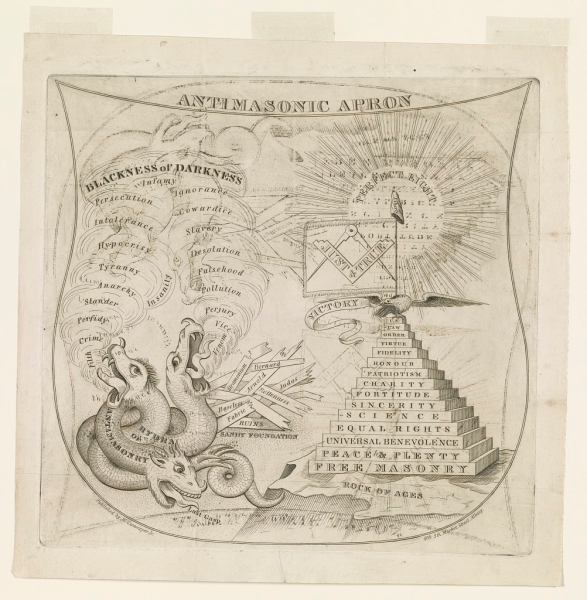
Anti-Masonic apron
IMAGE LINKED: Library of Congress Prints and Photographs Division Washington, D.C. Attribution 4.0 International (CC BY 4.0)
No sooner had Masonry recovered from this or-deal than the dark clouds of Civil War covered the land like a pall—the saddest of all wars, dividing a nation one in arts and arms and historic memories, and leaving an entail of blood and fire and tears.
Let it be forever remembered that, while churches were severed and states were seceding, the Masonic order remained unbroken in that wild and fateful hour.
An effort was made to involve Masonry in the strife, but the wise counsel of its leaders, North and South, prevented the mixing of Masonry with politics; and while it could not avert the tragedy, it did much to mitigate the woe of it—building rainbow bridges of mercy and goodwill from army to army.
Though passion may have strained, it could not break the tie of Masonic love, which found a ministry on red fields, among the sick, the wounded, and those in prison; and many a man in gray planted a Sprig of Acacia on the grave of a man who wore the blue.
Some day the writer hopes to tell that story, or a part of it, and then men will under-stand what Masonry is, what it means, and what it can do to heal the hurts of humanity.
Even so it has been, all through our national history, and today Masonry is worth more for the sanctity and safety of this republic than both its army and its navy.
At every turn of events, when the rights of man have been threatened by enemies obvious or insidious, it has stood guard—its altar lights like signal fires along the heights of liberty, keeping watch.
Not only in our own land, but everywhere over the broad earth, when men have thrown off the yoke of tyranny, whether political or spiritual, and demanded the rights that belong to manhood, they have found a friend in the Masonic order—as did Mazzini and Garibaldi in Italy.
Nor must we be less alert and vigilant today when, free of danger of foes from without, our republic is imperilled by the negligence of indifference, the seduction of luxury, the machinations of politicians, and the shadow of a passion-clouded, impatient discontent, whose end is madness and folly; lest the most hallowed of all liberties be lost.
Love thou thy land, with love far-brought
From out the storied past, and used
Within the present, but transfused
Through future time by power of thought.
V
Truly, the very existence of such a great historic fellowship in the quest and service of the Ideal is a fact eloquent beyond all words, and to be counted among the precious assets of humanity.
Forming one vast society of free men, held together by voluntary obligations, it covers the whole globe from Egypt to India, from Italy to England, from America to Australia, and the isles of the sea; from London to Sidney, from Chicago to Calcutta.
In all civilized lands, and among folk of every creed worthy of the name, Masonry is found—and everywhere it upholds all the redeeming ideals of humanity, making all good things better by its presence, like a stream underflowing a meadow.
Also, wherever Masonry flourishes and is allowed to build freely after its divine design, liberty, justice, education, and true religion flourish; and where it is hindered, they suffer.
Indeed, he who would reckon the spiritual possessions of the race, and estimate the forces that make for social beauty, national greatness, and human welfare, must take account of the genius of Masonry and its ministry to the higher life of the race.
Small wonder that such an order has won to its fellowship men of the first order of intellect, men of thought and action in many lands, and every walk and work of life: soldiers like Wellington, Blucher, and Garibaldi; philosophers like Krause, Fichte, and John Locke; patriots like Washington and Mazzini; writers like Walter Scott, Voltaire, Steele, Lessing, Tolstoy [Ed: Leo Tolstoy was not a Freemason]; poets like Goethe, Burns, Byron, Kipling, Pike; musicians like Haydn and Mozart—whose opera, The Magic Flute, has a Masonic motif; masters of drama like Forrest and Edwin Booth; editors such as Bowles, Prentice, Childs, Grady; ministers of many communions, from Bishop Potter to Robert Collyer; statesmen, philanthropists, educators, jurists, men of science—Masons many, whose names shine like stars in the great world’s crown of intellectual and spiritual glory.
What other order has ever brought together men of such diverse type, temper, training, interest, and achievement, uniting them at an altar of prayer in the worship of God and the service of man?
For the rest, if by some art one could trace those invisible influences which move to and fro like shuttles in a loom, weaving the network of laws, reverences, sanctities which make the warp and woof of society—giving to statutes their dignity and power, to the gospel its opportunity, to the home its canopy of peace and beauty, to the young an enshrinement of inspiration, and to the old a mantle of protection; if one had such art, then he might tell the true story of Masonry.
Older than any living religion, the most widespread of all orders of men, it toils for liberty, friendship, and righteousness; binding men with solemn vows to the right, uniting them upon the only basis upon which they can meet without reproach—like those fibers running through the glaciers, along which sunbeams journey, melting the frozen mass and sending it to the valleys below in streams of blessing.
Other fibers are there, but none is more far-ramifying, none more tender, none more responsive to the Light than the mystical tie of Masonic love.

Robert Burns, Poet. After Alexander Nasmyth.
IMAGE LINKED: wikimedia Attribution 4.0 International (CC BY 4.0)
Truth will triumph. Justice will yet reign from sun to sun, victorious over cruelty and evil. Finally Love will rule the race, casting out fear, hatred, and all unkindness, and pity will heal the old hurt and heart-ache of humanity. There is nothing in history, dark as much of it is, against the ultimate fulfilment of the prophetic vision of Robert Burns—the Poet Laureate of Masonry:
Then let us pray, that come it may—
As come it will, for a’ that—
. . . . . . . . . . . .
That man to man, the world o’er
Shall brothers be, for a’ that.
Article by: Joseph Fort Newton
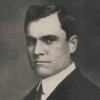
Rev. Newton (1880–1950) , was an American Baptist minister, authored a number of masonic books, including his best-known works, The Builders, published in 1914, and The Men’s House, published in 1923.
He received the third degree of Freemasonry on May 28, 1902 in Friendship Lodge No. 7, Dixon, Illinois, later affiliating with Mt. Hermon Lodge No. 263, Cedar Rapids, Iowa.
He also served as Grand Chaplain of the Grand Lodge of Iowa from 1911 to 1913 and Grand Prelate of the Grand Encampment of Knights Templar.
The Builders has been called "an outstanding classic in Masonic literature offering the early history of Freemasonry."
Recent Articles: The Builders by Joseph Fort Newton
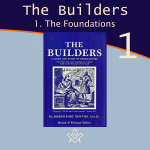 The Builders – 1 The Foundations Chapter 1. The Foundations Explore an outstanding classic in Masonic literature - an exposition of the early history and symbolism of Freemasonry – from the foundations upwards. |
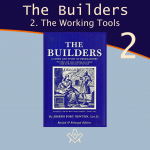 The Builders – 2 The Working Tools Chapter 2. The Working Tools - Explore an outstanding classic in Masonic literature - an exposition of the early history and symbolism of Freemasonry – from the foundations upwards. |
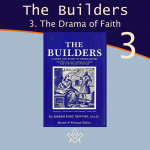 The Builders – 3 The Drama of Faith Chapter 3. The Drama of Faith - Explore an outstanding classic in Masonic literature - an exposition of the early history and symbolism of Freemasonry – from the foundations upwards. |
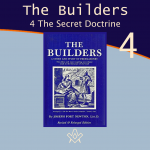 The Builders – 4 The Secret Doctrine Chapter 4. The Secret Doctrine - Explore an outstanding classic in Masonic literature - an exposition of the early history and symbolism of Freemasonry – from the foundations upwards. By Joseph Fort Newton |
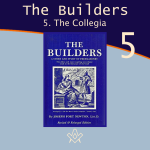 Chapter 5. The Collegia - If the laws of building were secrets known only to initiates, there must have been a secret Order of architects who built the temple of Solomon. Who were they? |
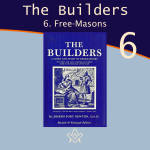 The Builders – 6 The Free-Masons Chapter 6. the Free-Masons - an examination into the history of the medieval guilds, their charges and regulations that form the base for the allegories and symbols in our modern versions of masonic craft ritual. By Joseph Fort Newton |
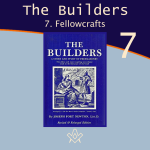 Chapter 7. the Fellowcrafts - an examination into the history of the medieval guilds, their charges and regulations that form the base for the allegories and symbols in our modern versions of masonic craft ritual. By Joseph Fort Newton |
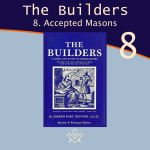 The Builders – 8 Accepted Masons Chapter 8. Accepted Masons - an examination into the history of accepted masons, and why did soldiers, scholars, antiquarians, clergymen, lawyers, and even the nobility ask to be accepted as members of the order of Free-masons? By Joseph Fort Newton |
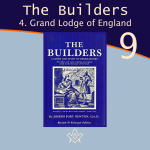 The Builders – 9 Grand Lodge of England Chapter 9. Grand Lodge of England - From every point of view, the organization of the Grand Lodge of England, in 1717, was a significant and far-reaching event. By Joseph Fort Newton |
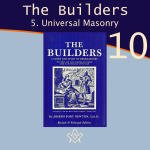 The Builders – 10 Universal Masonry Chapter 10. Universal Masonry - Henceforth, the Masons of England were no longer a society of handicraftsmen, but an association of men of all orders and every vocation, as also of almost every creed, |
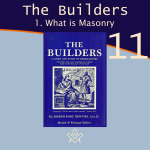 The Builders – 11 What is Masonry Chapter 11 "Masonry is the activity of closely united men who, employing symbolical forms borrowed principally from the mason's trade and from architecture, work for the welfare of mankind, striving morally to ennoble themselves and others, and thereby to bring about a universal league of mankind, which they aspire to exhibit even now on a small scale." |
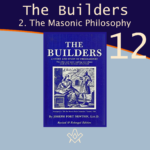 The Builders – 12 The Masonic Philosophy Chapter 12 When we look at Masonry in this large and mellow light, it is like a stately old cathedral, gray with age, rich in associations, its steps worn by innumerable feet of the living and the dead—not piteous, but strong and enduring. By Joseph Fort Newton |
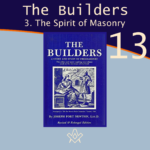 The Builders – 13 The Spirit of Masonry Chapter 13 Masonry is Friendship—friendship, first, with the great Companion, of whom our own hearts tell us, who is always nearer to us than we are to our-selves, and whose inspiration and help is the greatest fact of human experience. |
masonic knowledge
to be a better citizen of the world
share the square with two brothers

click image to open email app on mobile device



